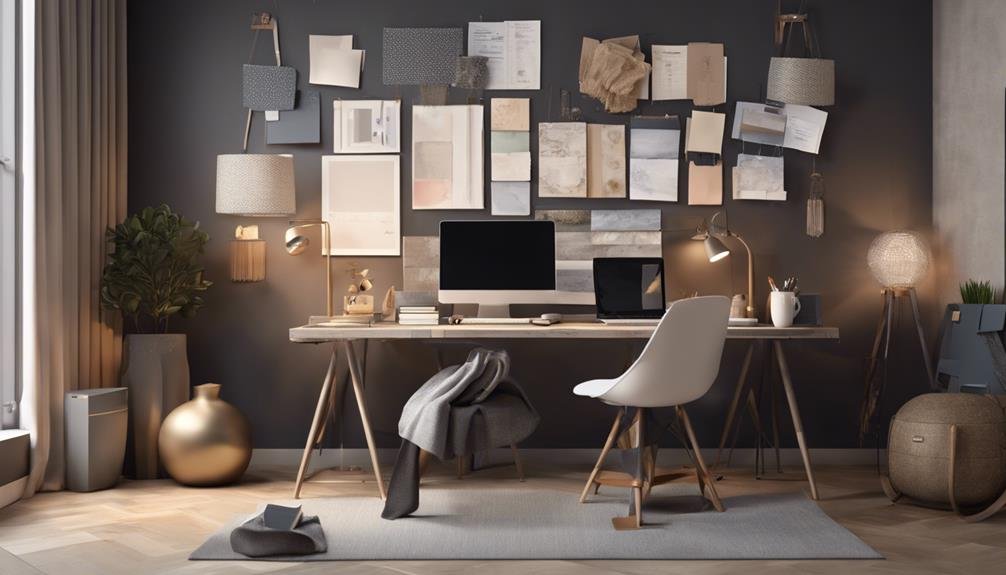How to Start a Business in Interior Design
To start an interior design business, begin by perfecting your design skills. Practice consistently, experiment with color, texture, and attend workshops for insights. Next, define your niche and target market. Analyze trends, differentiate from competitors, and set competitive pricing. Guarantee proper business registration, create a budget, develop a branding strategy, and establish workflows. Build a strong portfolio showcasing versatility and maintain an online presence. Market your business through social media engagement, networking, collaborations, and partnerships. Each step is essential for success in the competitive interior design industry.
Key Takeaways
- Validate business registration for legal compliance.
- Budget for essential expenses like software and materials.
- Devise a branding strategy for strong identity.
- Invest in tools to streamline the design process.
- Establish clear workflows for efficient project management.
Develop Your Design Skills
To excel in the field of interior design, hone your creativity and technical proficiency through consistent practice and learning. Mastering practice techniques is essential in refining your design skills. Dedicate time each day to sketching, experimenting with color palettes, and exploring different textures to enhance your artistic abilities.
Attending workshops can also provide valuable insights and hands-on experience to broaden your design knowledge. Workshops offer a platform to learn from industry experts, gain exposure to new trends, and network with fellow designers. Take advantage of these opportunities to enhance your skill set and stay updated on the latest advancements in interior design.
Additionally, workshops often provide practical exercises that can help you apply theoretical concepts to real-world scenarios.
Define Your Niche and Target Market
Refining your design skills through practice and learning will naturally lead you to define your niche and target market in the dynamic field of interior design. To effectively position your interior design business and attract the right clients, conducting thorough market research and competitor analysis is essential. Understanding the existing market landscape will help you identify gaps where your unique style and expertise can shine.
| Key Steps | Description | Benefits |
|---|---|---|
| Market Research | Analyze trends, customer preferences, and industry demands to tailor your services | Identify opportunities for growth |
| Competitor Analysis | Study your competitors to differentiate your brand and offer unique value propositions | Position your business effectively |
| Brand Positioning | Define what sets your interior design business apart and communicate your unique selling points | Establish a strong brand identity |
| Pricing Strategy | Determine competitive pricing based on your target market, costs, and perceived value | Attract clients while maintaining profitability |
Set Up Your Business Infrastructure
Establishing a solid business infrastructure is essential for laying a strong foundation for your interior design venture. Begin by tackling the administrative side of things: validate proper business registration to legitimize your operations.
Set up your office space in a way that reflects your brand and inspires creativity. When it comes to financial planning, create a budget that accounts for initial expenses like software, materials, and marketing efforts.
Simultaneously, devise a branding strategy that communicates your unique style and sets you apart in the competitive interior design market. Consistency in branding across all platforms is key to building brand recognition and trust with potential clients.
Consider investing in tools and software that can streamline your design process and enhance client communication. Additionally, establishing clear workflows and protocols for project management will help you stay organized and deliver projects efficiently.
Building a strong business infrastructure from the start will position you for success as you launch your interior design venture.
Create a Strong Portfolio
Crafting a compelling portfolio is crucial for showcasing your design expertise and attracting potential clients to your interior design business. Your portfolio presentation should be a reflection of your style, creativity, and attention to detail.
Include a variety of projects that demonstrate your versatility and skills, such as residential, commercial, and even personal projects. Make sure that each project is well-documented with high-quality images that capture the essence of your design vision.
To enhance client engagement, consider adding descriptions to your portfolio that provide insight into your design process, inspirations, and solutions you implemented. This personal touch can help potential clients connect with your work on a deeper level.
Additionally, maintaining a strong online presence through a professional website and social media platforms can increase your visibility and attract more clients. Leveraging networking opportunities within the interior design industry can also help you expand your reach and gain valuable referrals.
Market Your Interior Design Business
Elevating your interior design business through strategic marketing efforts is essential for attracting clients and establishing a strong presence in the industry.
To effectively market your interior design business, consider the following key strategies:
- Utilize Social Media Strategies: Engage with your audience through platforms like Instagram, Pinterest, and Facebook. Showcase your work, share design tips, and interact with potential clients to build a strong online presence.
- Attend Networking Events: Make connections within the industry by attending trade shows, conferences, and local networking events. Networking provides opportunities to meet potential clients, collaborate with other professionals, and gain insights into the latest trends.
- Explore Collaborations: Partnering with other businesses such as furniture stores, real estate agencies, or home builders can expand your reach and attract new clients. Collaborations allow you to tap into new markets and offer unique services to a broader audience.
- Form Strategic Partnerships: Build relationships with suppliers, contractors, and other professionals in the field. Strong partnerships can lead to referrals, cost savings, and enhanced credibility for your interior design business.
Frequently Asked Questions
Do I Need Formal Education to Succeed in Interior Design?
You can succeed in interior design without formal education. Self-taught designers often excel through experience. While qualifications can be beneficial, practical skills and a strong portfolio can also lead to success in the industry.
How Can I Effectively Network Within the Industry?
To effectively network in the interior design industry, attend industry events to meet professionals, collaborate on projects to showcase your skills, engage on social media to expand your reach, and seek mentorship relationships for guidance and support.
What Software Tools Are Essential for an Interior Designer?
To excel in interior design, essential tools include design software like AutoCAD for drafting and 3D rendering. Use project management tools for organization and client communication. Stay updated on industry-specific software to streamline your design process effectively.
Should I Offer Free Consultations to Attract Clients?
Offering free consultations can be a smart move. It showcases your expertise, builds trust, and attracts potential clients. Consider it a marketing technique to entice clients in, leading to client retention, portfolio building, and favorable pricing strategies.
How Do I Handle Difficult Clients and Conflicts Professionally?
When dealing with difficult clients, focus on conflict resolution by listening actively, empathizing with their concerns, and offering solutions. Maintain professionalism, set clear boundaries, and communicate effectively to manage clients and conflicts successfully.
Conclusion
Now that you have honed your design skills, defined your niche, set up your business infrastructure, and created a strong portfolio, it's time to embrace your creativity and market your interior design business to the world.
Like a well-crafted room, your business should reflect your unique style and expertise, drawing in clients like a magnet.
With determination and passion, you can turn your dream of owning a successful interior design business into a reality.







